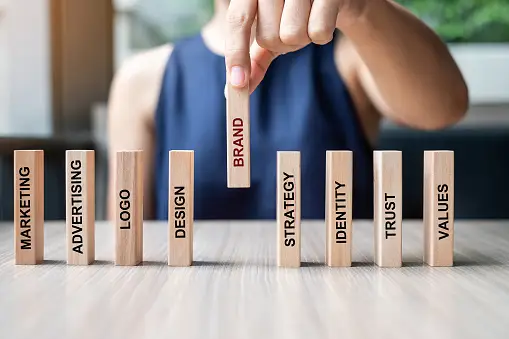What is a brand?
Brands help people recognize a company, product, or person. Brands are invisible and intangible. They influence how people view companies, products, and people. Markers help brands establish market identities. They give companies and individuals a competitive edge in their industry. Many companies obtain trademarks to protect their brands.
Related articles:
How Can I Create a Business Model?
Key takeaways
Brands help people recognize companies, products, and people.
Logos, slogans, and other marketing tools often need clarification with brands.
Companies value their brands.
Trademarks protect brands.
Corporate, personal, product and service brands exist.
Knowing Business Brands
Brands are intangible assets that help people recognize a company and its products. This is especially true when companies must differentiate between generic brands and others selling similar products. Advil, a famous brand of ibuprofen, distinguishes itself from generic versions sold in drugstores—brand equity.
Logos, slogans, and other company marks often must be corrected for brands. They are different but often used interchangeably. Companies promote their products and services using the former. These tools form a brand. Successful marketing can keep a company’s brand top-of-mind. This may determine a customer’s brand preference.
Companies value their brands highly. Many companies are known for their brand, making them one. Coca-Cola became synonymous with the company. Its high value affects the bottom line and, for public companies, shareholder value.
Companies must legally protect their brands. Trademarks show ownership of a brand, product, and marketing tools. Trademarks prevent unauthorized use of your goods and services.
Unique Things to Think About
Brands aren’t corporate. In the age of reality T.V. and social media, people use them too. The reality show helped the Kardashian family build brand value. Using its name, the family has launched media, modeling, spinoff shows, cosmetics, perfumes, and clothing lines.

Brand History
Brands have long-distinguished products. Merchants may have used branding in 2000 B.C. to sell their goods in different markets. It was a common way to show ownership at the time.
The branding is old. Italian paper was branded with watermarks in the 13th century. Brands are also the marks burned into cattle hides to identify their owners.
Rural America used it most. Ranchers used branding to identify their cattle. Companies began branding their products in the 19th century to differentiate themselves.
Kinds of Brands
Brands vary by user. Common brands include:
Corporate Brands: Companies use corporate branding to gain a competitive edge. Pricing, mission, target market, and values are crucial to this.
Personal Brands: Branding isn’t just for companies anymore. Social media helps people brand themselves. This includes social media posts, sharing photos and videos, and meet-and-greets.
Product Brands: Merchandise branding involves marketing one product. Branding requires market research and target market selection.
Service Brands: Service branding requires creativity since services can’t be seen.
Brand Creation
A company’s brand identity—how it wants to be seen—must be determined before it chooses a brand. Company logos often include slogans, products, or messages. Consumers should remember and like the brand.
The company usually consults a design firm, team, or logo design software to create a logo or symbol. Successful brands convey the company’s message. Brand awareness—the brand’s existence and offerings—results. Miscommunication causes ineffective brands, however.
Brand equity is built when targeting customers like a brand. Microsoft, Coca-Cola, Ferrari, Apple, and Meta (formerly Facebook) are well-known brands.
Branding can boost sales for the product and other products the same company sells. After a good product experience, consumers are likelier to try another product from the same brand. Brand loyalty describes this phenomenon.
Brand Benefits
Branding benefits large and small businesses and individuals. Branding creates many impressions. Then what? A company that can communicate can move its customers. These companies profit from their unique relationships with these consumers. These customers help companies attract new customers.
This boosts company credibility. After all, consumers prefer brands they trust. Companies gain a competitive advantage. Brand awareness boosts profits.
It also helps companies launch new products. Even if new products are more expensive, loyal customers will buy them because they trust and like the brand.
Take Apple. Due to brand loyalty, customers are willing to pay more for an iMac, MacBook, iPad, or iPhone. Many customers are willing to upgrade when the company releases new electronics.
What Are 4 Different Types of Brands?
There are many kinds of brands, but the most common ones are:
corporate
personal
product
and service.
What Are Examples of Brands?
Brands are intangible, but we associate them with products and names. Apple, Nike, Coca-Cola, Advil, and Tylenol.

Is a Brand Important?
Brands make companies and people money. They also give an organization a market advantage. Successful branding increases a company’s customer base and builds trust, credibility, and brand loyalty, giving it a competitive edge and a higher bottom line.
What’s Brand Equity?
Brand equity is a company’s product or service’s value compared to a generic alternative. Compare Advil to generic drugstore ibuprofen.
Bottom Line
Most people associate “brand” with logos, slogans, and other marks. That’s just one definition. Brands are intangible marketing concepts that help people recognize a business or person.
Brands are a company’s most valuable asset. They can make or break a company, so firms must research them before launching a product or service or opening for business. Successful branding can attract and retain customers, building brand loyalty and giving the company an edge.




